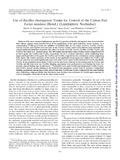Mostrar el registro sencillo del ítem
Use of Bacillus thuringiensis toxins for control of the cotton pest earias insulana (Boisd.) (Lepidoptera: Noctuidae)
| dc.creator | Ibarguchi Mendía, M.ª Ángeles | es_ES |
| dc.creator | Estela, Anna | es_ES |
| dc.creator | Ferré, Juan | es_ES |
| dc.creator | Caballero Murillo, Primitivo | es_ES |
| dc.date.accessioned | 2019-01-23T11:16:16Z | |
| dc.date.available | 2019-01-23T11:16:16Z | |
| dc.date.issued | 2006 | |
| dc.identifier.issn | 0099-2240 (Print) | |
| dc.identifier.issn | 1098-5336 (Electronic) | |
| dc.identifier.uri | https://hdl.handle.net/2454/32074 | |
| dc.description.abstract | Thirteen of the most common lepidopteran-specific Cry proteins of Bacillus thuringiensis have been tested for their efficacy against newly hatched larvae of two populations of the spiny bollworm, Earias insulana. At a concentration of 100 μg of toxin per milliliter of artificial diet, six Cry toxins (Cry1Ca, Cry1Ea, Cry1Fa, Cry1Ja, Cry2Aa, and Cry2Ab) were not toxic at all. Cry1Aa, Cry1Ja, and Cry2Aa did not cause mortality but caused significant inhibition of growth. The other Cry toxins (Cry1Ab, Cry1Ac, Cry1Ba, Cry1Da, Cry1Ia, and Cry9Ca) were toxic to E. insulana larvae. The 50% lethal concentration values of these toxins ranged from 0.39 to 21.13 μg/ml (for Cry9Ca and Cry1Ia, respectively) for an E. insulana laboratory colony originating from Egypt and from 0.20 to 4.25 μg/ml (for Cry9Ca and Cry1Da, respectively) for a laboratory colony originating from Spain. The relative potencies of the toxins in the population from Egypt were highest for Cry9Ca and Cry1Ab, and they were both significantly more toxic than Cry1Ac and Cry1Ba, followed by Cry1Da and finally Cry1Ia. In the population from Spain, Cry9Ca was the most toxic, followed in decreasing order by Cry1Ac and Cry1Ba, and the least toxic was Cry1Da. Binding experiments were performed to test whether the toxic Cry proteins shared binding sites in this insect. 125I-labeled Cry1Ac and Cry1Ab and biotinylated Cry1Ba, Cry1Ia, and Cry9Ca showed specific binding to the brush border membrane vesicles from E. insulana. Competition binding experiments among these toxins showed that only Cry1Ab and Cry1Ac competed for the same binding sites, indicating a high possibility that this insect may develop cross-resistance to Cry1Ab upon exposure to Cry1Ac transgenic cotton but not to the other toxins tested. | en |
| dc.description.sponsorship | This study was funded by the Spanish Ministry of Science and Technology (grants AGL2000-0840 and AGL2003-09282) and the Generalitat Valenciana (grant GRUPOS2004-21). M.A.I. and A.E. received support from the Spanish Ministry of Education and Culture (grants FP2000-4923 and FP2000-5497). | en |
| dc.format.extent | 6 p. | |
| dc.format.mimetype | application/pdf | en |
| dc.language.iso | eng | en |
| dc.publisher | American Society for Microbiology | en |
| dc.relation.ispartof | Applied and Environmental Microbiology, vol. 72, nº 1, jan. 2006, p. 437–442 | en |
| dc.rights | © 2006, American Society for Microbiology. All Rights Reserved. | en |
| dc.subject | Bacillus thuringiensis | en |
| dc.subject | Toxins | en |
| dc.subject | Control of the cotton pest earias insulana | en |
| dc.title | Use of Bacillus thuringiensis toxins for control of the cotton pest earias insulana (Boisd.) (Lepidoptera: Noctuidae) | en |
| dc.type | info:eu-repo/semantics/article | en |
| dc.type | Artículo / Artikulua | es |
| dc.contributor.department | Producción Agraria | es_ES |
| dc.contributor.department | Nekazaritza Ekoizpena | eu |
| dc.rights.accessRights | info:eu-repo/semantics/openAccess | en |
| dc.rights.accessRights | Acceso abierto / Sarbide irekia | es |
| dc.identifier.doi | 10.1128/aem.72.1.437-442.2006 | |
| dc.relation.publisherversion | https://doi.org/10.1128/aem.72.1.437-442.2006 | |
| dc.type.version | info:eu-repo/semantics/publishedVersion | en |
| dc.type.version | Versión publicada / Argitaratu den bertsioa | es |


